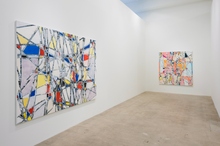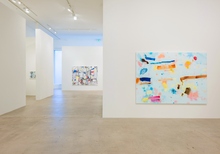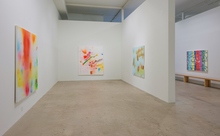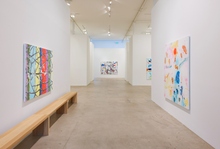Diane Rosenstein Fine Art is pleased to announce Arnold Helbling: Drop City, a solo exhibition of paintings by the Swiss-born artist. Mr. Helbling offers luminous and dynamic canvases that present abstracted views of utopian environments, both literal and conceptual. Drop City will present new paintings from the artist's Architectonics series in conversation with earlier compositions based on found images of Parisian housing projects. These contemplative canvases (2002 - 2004) reaffirm the artist's abiding interest in structure - both ideological and environmental. This is Mr. Helbling's first show with the gallery, and in Los Angeles.
The paintings exhibited in Drop City draw from Helbling's alignment to the Emersonian aspirations at the heart of American Transcendentalism. Viewing nature through this singular vision, Arnold Helbling abstracts its forms and renders them with a dis-tinctive palette featuring tones simultaneously soft and lush. The imagery is both representational (microscopic and cellular) and an abstraction of the macrocosmic urban grid.
The title of the exhibition refers directly to the 1960s utopian commune near Trinidad, Colorado. Formed by a group of art students and filmmakers from University of Kansas, "Drop City" was dedicated to living the concept of "Drop Art" - an early performance art practice of dropping small, painted objects from a roof and noting the reactions of passersby. The community was formed as residents assembled recycled materials into makeshift geodesic domes (á la Buckminster Fuller). We get a glimpse of these domes in the geometry of the Architectonics.
The artist's formal practice is similarly performative: he applies acrylics onto canvas using an elaborate transfer method involving plastic sheeting. The result is a silken and sculptural surface permeated by a network of veins and creases. The palette remains exuberant, and in Victory Boogie Woogie (2013), the yellows and blues pay homage to Piet Mondrian's last unfinished canvas. The immediacy of these paintings transfers a whole host of interwoven experiences and histories.
Also on view in Drop City is a selection of early paintings, including Zabriskie 5 (2002) from Everything Falls Apart Yet Nothing Ever Does (Roebling Hall, 2003). These bold abstractions, derived from found images of suburban housing projects outside Paris, are transformed into mystical landscapes by the artist's bravura array of painterly techniques. Using broad brush strokes, drips, and airbrushing, Helbling dazzles the viewer with subtle shifts in surface and ground, revealing the influence of Qing Dynasty painter, and "crazy" monk, Bada Shanren (born Zhu Dha, 1626 - 1705).
Bada Shanren was born a prince then, in 1644, abruptly became a Buddhist monk shortly after the fall of the Ming Dynasty either to redress the psychic trauma of the revolution, to avoid persecution, or both. Known for his unique expressionist calligraphic style that diverged significantly from customary Chinese landscape painting of the period, Bada rendered enigmatic paintings of fish, birds, plants and landscapes in subtle strokes of ink.
Arnold Helbling's paintings exhibited in Drop City draw on the his ideological connections to Transcendentalism and Utopianism, stylistic associations with Bada Shanren's 17th Century Chinese scroll paintings, and his continuous exploration of the role of structure in formal and physical spaces. Mr. Helbling, who has been based in New York City since 1989, received his MFA from the Basel School for Art, Basel, Switzerland (1987).
He has exhibited his paintings widely in the United States, Europe, and Asia, most recently in Das grüne Rauschen at Kunstraum Baden, Baden, Switzerland (2013), Into The Wild, Galerie Zimmermannhaus, Brugg, Switzerland (2012), and a solo exhibition, Building C, at Von Lintel Gallery, in New York City. Helbling has shown in museums and institutions, including the Sungkok Art Museum, Seoul, Korea, the Helmhaus, Zurich, Switzerland, and the Aargauer Kunsthaus, Aarau, Switzerland. His work is in public collections including the Schweizerische Eidgenossenschaft, Bern; Stadt, Switzerland; and the Neuberger Museum of Art, State University of New York, Purchase, NY.









